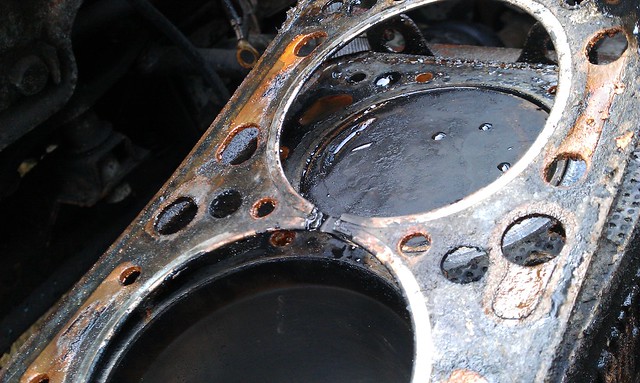How to Fix a Blown Head Gasket Without Replacing It
To fix a blown head gasket without replacing it, you can use a high-quality head gasket sealer. This product seals the leak in the gasket, preventing further damage.
Dealing with a blown head gasket can be a daunting task for many vehicle owners. It often leads to expensive repair costs and extensive downtime. However, by using a head gasket sealer, you can effectively fix the issue without having to replace the entire gasket.
This cost-effective solution offers a quick fix to get your car back on the road in no time. We will explore the benefits of using a head gasket sealer, how to apply it, and the potential drawbacks to be aware of.
Common Signs Of A Blown Head Gasket
The head gasket plays a critical role in the engine’s functionality by sealing the combustion chamber and preserving the high pressure and temperature produced during the combustion process. When the head gasket fails, it can cause a variety of issues that need immediate attention. Therefore, understanding the common signs of a blown head gasket is essential to prevent further damage to your vehicle.
Overheating Engine
An overheating engine can be a clear indication of a blown head gasket. If your temperature gauge consistently shows high readings, or if your vehicle frequently overheats, it may be due to the head gasket failing to seal the coolant passages properly. This can lead to the engine running hotter than normal and could cause severe damage if left unresolved.
White Exhaust Smoke
The presence of white exhaust smoke can signal a blown head gasket. When the head gasket fails, coolant can leak into the combustion chamber, resulting in the production of white smoke from the tailpipe. This is often accompanied by a sweet smell, indicating a coolant leak and potential head gasket failure that must be addressed promptly.
Bubbles In Radiator Or Coolant Reservoir
Bubbles in the radiator or coolant reservoir are another sign of a blown head gasket. If you notice air bubbles rising to the surface of the coolant in your radiator or reservoir, it could indicate that combustion gases are infiltrating your vehicle’s cooling system due to a compromised head gasket. This can lead to overheating and potential engine damage if left unresolved.
Credit: www.quora.com
Temporary Fixes For A Blown Head Gasket
If your car is experiencing a blown head gasket, there are temporary solutions you can try to address the issue without immediately replacing the gasket.
Using A Head Gasket Sealer
A head gasket sealer can be an effective temporary fix for a blown head gasket by sealing the leak and preventing further damage.
- Choose a reputable head gasket sealer product.
- Follow the manufacturer’s instructions for application.
- Monitor your vehicle for any changes after applying the sealer.
Using A Coolant Leak Repair Product
Coolant leak repair products can also offer a temporary solution for a blown head gasket, helping to seal the leak and maintain engine performance.
- Research and select a reliable coolant leak repair product.
- Apply the product as directed on the packaging.
- Keep an eye on your vehicle’s coolant levels and temperature.
Preparation For The Repair Process
When fixing a blown head gasket without replacing it, proper preparation is key. Follow these steps to ensure a successful repair process.
Gathering Necessary Tools And Materials
Prepare the required tools and materials before starting the repair process:
- Socket wrench set: Essential for removing engine components.
- Gasket sealant: Needed to create a seal between parts.
- Thick gloves and safety goggles: Protect yourself during the repair.
- New coolant: To refill the system after the repair.
Performing A Thorough Engine Inspection
Before proceeding, inspect the engine to ensure a successful repair:
- Check for coolant leaks: Look for signs of coolant around the engine.
- Inspect the oil: Milky appearance indicates coolant mixing with oil.
- Perform a compression test: To assess the cylinder’s condition.

Credit: barsleaks.com
Step-by-step Guide To Fix A Blown Head Gasket
Step-by-step guide to fix a blown head gasket
Draining Coolant And Removing Necessary Components
Begin by draining the coolant from the engine and removing the necessary components to access the head gasket.
Cleaning The Engine And Head Gasket Surfaces
Clean the engine and head gasket surfaces thoroughly to ensure a proper seal using a suitable degreaser and a rag.
Applying The Head Gasket Sealer Or Coolant Leak Repair Product
Apply the head gasket sealer or coolant leak repair product carefully, following the manufacturer’s instructions, to seal the blown head gasket effectively.
Reinstalling Components And Refilling Coolant
Reinstall the components that were removed and refill the coolant to the appropriate level, ensuring there are no air pockets in the system.
Testing For Leaks And Monitoring For Improvement
After reassembling, test for leaks and monitor for improvement, checking for any signs of coolant leakage and ensuring the repair has been successful.
Preventive Measures To Avoid Future Blown Head Gasket Issues
Preventive measures to avoid future blown head gasket issues
-
Regular Maintenance And Inspection
Regular maintenance and inspection is crucial in preventing a blown head gasket. By following a routine maintenance schedule, you can identify and address any issues before they escalate and cause major damage. Make sure to regularly check the oil and coolant levels, as well as the overall condition of the engine. Look out for any signs of leaks, unusual noises, or excessive smoke coming from the exhaust system.
-
Avoiding Engine Overheating
One of the primary causes of a blown head gasket is engine overheating. To prevent this, it is essential to keep your engine temperature within the recommended range. To avoid overheating, make sure your cooling system is functioning properly. Check for any blockages in the radiator or coolant passages and replace any faulty components such as the thermostat or water pump. Additionally, avoid pushing your engine to its limits and refrain from towing heavy loads for extended periods, as this can put excessive strain on the head gasket.
-
Using High-quality Coolant And Engine Oil
Using high-quality coolant and engine oil is essential for the health of your head gasket. Coolant helps regulate the temperature in the engine, preventing it from overheating and causing damage. Opt for a coolant that is specifically designed for your vehicle’s requirements and replace it according to the manufacturer’s recommendations. Similarly, using the right grade and type of engine oil can help reduce friction and heat within the engine, reducing the risk of a blown head gasket. Regularly change the engine oil and ensure it meets the specifications of your vehicle.

Credit: www.kseal.com
Frequently Asked Questions On How To Fix A Blown Head Gasket Without Replacing It
Can You Fix A Head Gasket Without Replacing It?
Yes, it is possible to fix a head gasket without replacing it using a sealant. However, it is not a permanent solution and may not be effective in all cases. It’s best to consult a professional mechanic for a long-term fix.
What Is The Cheapest Way To Fix A Blown Head Gasket?
The cheapest way to fix a blown head gasket is to use a head gasket sealant.
Do Any Head Gasket Sealers Work?
Yes, some head gasket sealers can be effective in temporarily addressing minor leaks. It is important to carefully follow product instructions for best results.
What Can Be Mistaken For A Blown Head Gasket?
Common issues mistaken for a blown head gasket include radiator leaks, damaged thermostat, or cracked engine block. Look for coolant leaks, overheating, or white smoke from the exhaust as signs of a blown head gasket.
Can A Blown Head Gasket Be Fixed Without Replacing It?
Yes, it is possible to fix a blown head gasket without replacing it by using certain sealants and additives.
What Are The Signs Of A Blown Head Gasket?
Common signs of a blown head gasket include excessive white smoke from the exhaust, overheating engine, milky oil, and loss of coolant.
How Long Can You Drive With A Blown Head Gasket?
Driving with a blown head gasket is not recommended as it can cause further engine damage. It’s best to have it repaired as soon as possible.
Conclusion
Managing a blown head gasket without outright replacement is possible but requires careful attention and timely action. Utilizing sealants and following procedures can help restore functionality, but it’s important to monitor for potential issues. Considering long-term alternatives or professional repair may be necessary for lasting results.
Taking proactive measures can save time and money in the long run.

